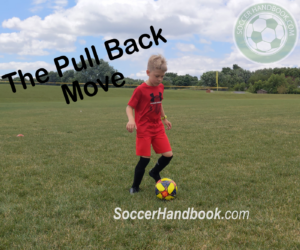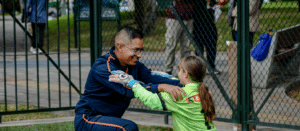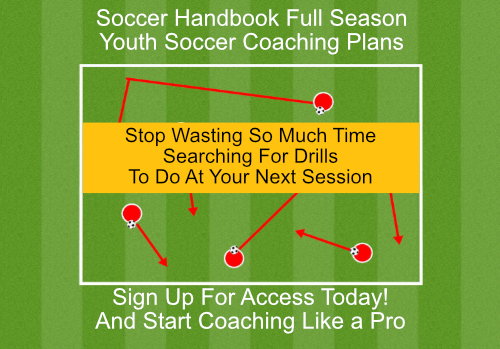Soccer is often called “the beautiful game,” but before it can be played beautifully, you need to master basic soccer skills. And it is essential to know that beginners should learn the fundamentals of soccer before trying fancy tricks or moves that the pros do. If not, they may become frustrated and lose interest in the game.
The game is often used to teach young children teamwork, competition, and to build the fundamentals of a healthy, active life. While this is a good start, the younger kids are when they learn how to play the game correctly, the better their foundation will be for a long soccer career.
But really you can learn the game of soccer at any age!
Are you a parent or a volunteer coach? Are you tired of spending so much time searching for drills and looking for help with practices? Then check out our Full Season Coaching Handbooks. They include full seasons of training sessions, all in one place!
Below Are 4 Basic Soccer Skills and Fundamentals
**Plus 1 bonus concept that every player should learn.
1. Passing
Passing is our first fundamental.. well because soccer is a team sport.
Accurate passing allows you to move the ball from one player to a teammate. This is so important because you can move the ball around the field faster and with less effort than dribbling.
I once heard a coach say,
“You will never be able to dribble faster than the football can be passed.”
This is very important to remember, plus dribbling is a skill for individuals, and soccer is a team sport.
To pass effectively, it is vital that beginner and youth players learn where their teammates are by keeping their heads up and looking around. For the player without the ball, it is essential to communicate. Calling for the ball and letting your teammate know where you are is just as crucial as getting your head up.
There are many techniques for how to pass a soccer ball, but the most basic is to pass with the inside of the foot. This gives the player the most control and accuracy.
To pass with the inside of the foot, follow these steps:
- Use the inside of your foot
- Plant your non-kicking foot on the ground next to the ball
- Lock your ankle
- Follow all the way through when making contact with the ball
Watch our video to see it in action, and visit our page for How to Kick a Soccer
2. Dribbling
Dribbling is all about ball control and is also part of basic soccer skills. Passing and dribbling are the two ways a player can move the ball down the field. As I mentioned already, dribbling the ball is a skill for individuals.
Typically you can dribble fastest when you have an open space in front of you. It is also used to get past other players and advance the ball.
To dribble, new players should start with the inside of their foot and as their comfort and speed with the ball increase, the top of the foot may feel more comfortable. The objective is to keep the ball close to your body in order to make quick decisions about whether to pass, change direction or shoot at the goal. As players become more experienced, they can train to use more parts of their foot to dribble.
3. Trapping / Receiving the Ball
Receiving the ball or trapping the ball is a critical skill for soccer because if you can’t settle the ball and get it under control, you will lose it before you have an opportunity to do anything with the ball. Receiving the ball should be practiced in coordination with passing.
If the ball is on the ground
- A player will need to turn the ankle as if they are passing the ball.
- Then with the knee bent, cushion the ball so it stops in front of them
- Then they can either dribble or pass the ball next
It is critical that beginners and youth players master this skill before moving on to more controlling, more challenging balls, such as balls in the air.
4. Shooting The Ball
As the great Cruijff once said.
“‘You can’t score if you don’t shoot”
-Johan Cruijff
The game of football is won by scoring goals, and if you never shoot, you can’t score, and you can win. Winning isn’t everything, but, well, it is kind of the point of the game.
As a soccer newbie, it is important to start with the most basic shooting technique. It’s not just about the power you need to have control and accuracy as well.
Basic shooting techniques in Soccer
- First, as you approach the ball, plant the support (non-kicking) foot next to the ball with your toes toward the goal.
- Make sure you have enough distance from the ball so you can strike the ball with your shooting foot.
- Keep your eyes on the ball.
- Keep your ankle locked and your knee over the ball.
- Then strike the ball with your laces and in the middle of the ball.
Check out our video for How To Shoot a Soccer Ball as well.
5. Movement Off The Ball ** (Bonus Skill)
The last skill in our list is often considered a bit more advanced than other basic soccer skills, but it is also critical to understanding the game of soccer.
This is movement off the ball or movement when you don’t have the ball. I’m sure we’ve all heard the expression “bumblebee soccer.” This typically happens with young kids in youth soccer. The kids swarm around the ball, and wherever it goes, so do all the kids. This usually means there isn’t much passing or even dribbling. It is mostly just kicking at the ball. The sooner youth players can learn how to spread out and move the ball around the field, the more they will be able to contribute to the game.
How to move off the ball
When a player doesn’t have the ball, they should move to an open space. This gives the player with the ball an option to pass and quickly get the ball somewhere safe from the opponent. Then when the other team swarms to the ball, the next pass should go to another player that ran to a different open space. This will keep the other team running in circles all game.
Conclusion
Like anything else, Practice makes perfect, and these skills will help build a firm foundation.
To quote Cruijff again.
“Soccer is simple, but it is difficult to play simple.”
Johan Cruijff
It is essential that you, as a beginner or your child, master the basics of soccer before trying to play like the pros. That will help ensure the ability to play the game simply.
A good coach can teach basic soccer skills, but you can also learn a great deal from peers and a good game of pickup soccer.






